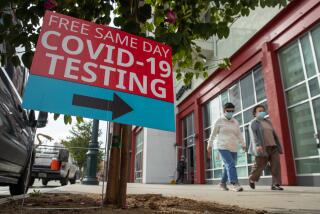Op-Ed: The COVID-19 vaccines are coming. Here’s how they should be rolled out

Sometime in the next few months we are likely to enter the era of COVID-19 vaccines. With billions of dollars poured into the multiagency federal effort Operation Warp Speed and positive signs coming from clinical trials, the odds seem high that one or more safe and relatively effective vaccines will be ready soon.
But getting ready and getting people immunized are two different things. Well before Operation Warp Speed delivers products en masse, we need to be prepared to distribute them effectively. Initially, we will have to prioritize some highest risk Americans over others, and — perhaps most challenging — we will have to persuade millions of reluctant or complacent Americans to get their shots.
To crush the virus, we need a moonshot-like goal: 150 million Americans vaccinated by Sept. 1, before next year’s school year and flu season. Only by achieving this level of immunization can we confidently achieve a sense of normalcy again.
How do we achieve that goal?
Even if we do develop a successful vaccine, is the government even capable of getting it to the people in time?
First, make any FDA-authorized vaccine completely free of charge. Our research shows cost will be a barrier for many Americans. Not only should the vaccines themselves be covered, so should the administration fees for pharmacies and distributors. The payment system must be simple so that red tape doesn’t delay delivery. The government is already buying doses through Operation Warp Speed, but it should formalize that process to guarantee all inoculations are free regardless of location or insurance.
Then set priorities for early distribution and get the initial target groups ready to line up for shots. When the vaccines are first approved, many more people will want them than can be accommodated. Healthcare workers will probably be the first priority. Next will be people at higher risk of serious illness or death, including the elderly, those living in nursing homes and jails, and those with suppressed immune systems. This is also the time to create a national registry that keeps track of who has been vaccinated, enabling long-term monitoring of the vaccine’s safety and efficacy.
Lay the pavement for rapid deployment of vaccines to the rest of us. Retail pharmacies and local healthcare providers will need help preparing to take on the massive task ahead, and they should not be alone on the front lines. Employers should incentivize their workers to get their shots at workplaces. Vaccinations should be required for all school employees and university students to address super spreading. Moreover, as soon as the first vaccine approaches availability, Operation Warp Speed should fund research on its safety and effectiveness in children. It is hard to imagine interventions like physical distancing and masks alone preventing all future superspreading events at schools.
Lastly, think big. Plan for a level of throughput that has never been achieved by our health system, which is usually characterized by fixed capacity, long waiting times and bricks-and-mortar facilities.
Public health agencies must be proactive and get creative. Vaccinators should show up wherever a crowd gathers, such as bars, nightclubs, parks and even the South Lawn of the White House. (At bars, instead of one shot, how about two?) Create a mobile registration system that eliminates the need for clipboards and insurance cards. This may be the way that the Apple and Google COVID-19 partnership achieves its potential. Launch free training programs to create new workers capable of administering vaccinations and pay them per vaccine delivered. Create a network of thousands of local distribution centers for vaccinators to pick up doses. This could be a great use of the 31,322 post offices in the U.S. simply by adding refrigerators and an inventory control system to track vaccine doses.
Finally, governments at all levels should coordinate with pharmaceutical companies, doctors and hospitals on a vaccination awareness campaign of a scale not seen since the advent of polio immunization. Unlike that tranquil time when trust in government and the medical establishment was high, the public today is rife with suspicion. For many millions, the delivery of vaccines in record time is a sign that something must be wrong or dubious.
The name Operation Warp Speed should be retired as soon as vaccines are approved and something more encouraging put in its place.
Behaviorists tell us that negative motivations don’t work as well as positive ones. “Get a shot, it’s your responsibility” has less appeal than “Everybody is getting immunized, and you should too.” When coupled with rewards for participation — maybe entry into a lottery after being added to the vaccine registry — the trend line toward herd immunity should move rapidly in the right direction.
The oncoming vaccines give us a chance to return to normalcy. The scientists did their job; now it is time for the rest of us to finish it.
Bob Kocher is a physician and a nonresident senior fellow at the USC Schaeffer Center for Health Policy and Economics. Previously he was a special assistant to President Obama for healthcare and economic policy. Dana Goldman is director of the Schaeffer Center.
More to Read
A cure for the common opinion
Get thought-provoking perspectives with our weekly newsletter.
You may occasionally receive promotional content from the Los Angeles Times.







